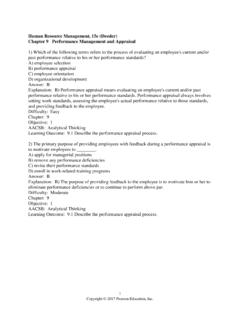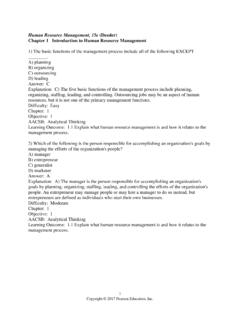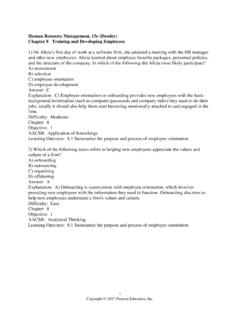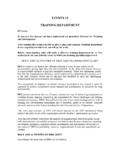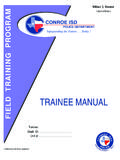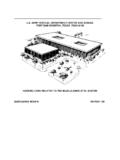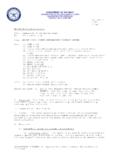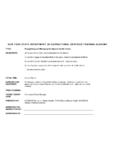Transcription of Appraisal Program (DPMAP) - cbafaculty.org
1 Instructor Guide lesson 1 Introduction DoD Performance Management and Appraisal Program ( dpmap ). Instructor Guide 1 dpmap July 2016. Instructor Guide lesson 1 Introduction This page intentionally left blank 2 dpmap July 2016. Instructor Guide lesson 1: Performance Management Overview DoD Performance Management and Appraisal Program ( dpmap ). COURSE OUTCOME. The overall course goal is to prepare supervisors and employees covered under dpmap for transition to the new performance management Program . METHODOLOGY. Lecture: Transmit information which supplements or enhances reading; promote understanding via explanations; respond to student misconceptions or difficulties;. create or engage interest in a new area; motivate reading or other assignments. Examples of lecture content includes: Create interest in the performance management Program , promote understanding via explanations; and respond to student misconceptions or difficulties. Discussions: Practice thinking and communicating in the subject/discipline; evaluate positions, arguments, or designs; defend own position; identify problems, conflicts and inconsistencies; get feedback from/about students; draw on students' expertise and prior knowledge.
2 Examples of discussion content includes: what engages people in the workplace; why constructive feedback is for the benefit of the employee;. identifying the barriers to performance success; planning methods of recording and celebrating performance success. TARGET AUDIENCE. The primary target audience is supervisors and employees covered under dpmap . About Facilitating MATERIALS NEEDED. Be sure you have the following materials, which will be needed to complete the activities: Instructor Guide/Slides Participant Guide/Slides Chart paper/easel (at least 3). 3 dpmap July 2016. Instructor Guide lesson 1: Performance Management Overview 3 x3 Post-It notes Stickers for voting, 5 per participant SETUP. Prior to a training session, be sure that the following setup has been completed: Practice with slides on session computer Test slides/practice in room Test microphone if used SPECIAL FACILITATION REQUIREMENTS. Keep the participants actively involved, but watch the time!
3 BEST PRACTICES. Here are some best practices for facilitating an instructor-led training course. 1. Refer to the Instructor's Guide and rely on the script. Rehearse the script several times so that you can paraphrase it in a natural way. To the degree the schedule allows, try to add information that supports or highlights the points being made in the slide ( , add examples from your own experience). 2. Encourage participation. Accomplish this by asking questions and by having the participants interact as directed. 3. Encourage participants to speak in turn. 4. Encourage participants to follow along in the Participant Guide. Become familiar with what is in the guide and refer to it whenever directed by the Instructor Guide. 5. At the end of a lesson , ask the participants what they remember. Let them summarize the major instructional points, if time permits. 6. Keep the atmosphere informal so that the participants are comfortable asking questions, participating in activities, and sharing their knowledge or concerns.
4 4 dpmap July 2016. Instructor Guide lesson 1: Performance Management Overview COURSE Introduction and Overview COURSE NAME. DoD Performance Management and Appraisal Program ( dpmap ). Duration 2 days PURPOSE. The purpose of this course is to prepare supervisors and employees covered under for transition to the new performance management Program . This training material will be used to review tasks and concepts from performance management, organizational effectiveness, and employee engagement needed to prepare for the implementation of dpmap . COURSE AGENDA. The course contains seven lessons. lesson 1: Performance Management Overview lesson 2: Engaged Employees lesson 3: Planning Performance lesson 4: Continuous Feedback lesson 5: Monitoring Performance lesson 6: Evaluating Performance lesson 7: Recognizing and Rewarding Performance Note: The lessons in this course are designed to be modular, allowing trainers to tailor the delivery of the course.
5 Each lesson can be used as an individual training resource. The participant guides have note sections on each page for participant's use. 5 dpmap July 2016. Instructor Guide lesson 1: Performance Management Overview lesson 1: Performance Management Overview PURPOSE. The purpose of lesson 1 is to provide an overview of performance management in general, and to specifically review requirements, processes, and responsibilities of both supervisors and employees in dpmap . LEARNING OBJECTIVES. When participants have completed lesson 1, they will be able to: Describe the relationship between performance management and the Department of Defense (DoD) mission and core values Identify key performance management roles and responsibilities Recognize significant performance management features Characterize the DoD performance management model TOPICAL OUTLINE. A. Performance Management (PM) Concept (1) Relationship to DoD Strategic Mission/Goals (2) Labor representatives' involvement (3) Rights of employees, unions, and management B.
6 DoD Performance Management Process (1) Planning work and setting expectations (2) Continually monitoring performance (3) Evaluating performance in a summary fashion (4) Recognizing and rewarding good performance C. DoD Core Values D. Key performance management levels and features E. DoD performance management model (1) Planning 6 dpmap July 2016. Instructor Guide lesson 1: Performance Management Overview (2) Monitoring (3) Evaluating TIME. The following is a suggested time plan for this lesson . The instructor(s) may adapt it as needed. Note this table does not reflect breaks use your judgement to determine the timing of breaks for participants. lesson SUGGESTED TIME. lesson 1: Performance Management 60 minutes with no break Overview 7 dpmap July 2016. Instructor Guide lesson 1: Performance Management Overview Instructor Notes Content Introduction to the DoD Performance SHOW SLIDE: 1. Management and Appraisal Program ( dpmap ). SAY. Welcome to DoD Performance Management and Appraisal Program or dpmap .
7 DO. Display the course title slide as participants arrive for training each morning. Welcome participants as they arrive for the class Give them their name tents and name tags Thank them for coming Check their names on the class roster and ensure that all of their data on the roster is correct Instructor Notes: These words represent the key messages SHOW SLIDE: 2. that embody what is most important about New Beginnings - Performance, Mission, Communication, Excellence, etc. DO. Display the New Beginnings slide at the beginning of each instructional day and during breaks. 8 dpmap July 2016. Instructor Guide lesson 1: Performance Management Overview Instructor Notes Content lesson 1: Performance Management SHOW SLIDE: 3. Overview SAY. Welcome to lesson 1: Performance Management Overview. DO. This is the start of lesson 1: Performance Management Overview. It is important to start the course with a positive, energetic tone and to establish your expertise and authority in the classroom.
8 SAY SHOW SLIDE: 4. Let's start with some introductions. Please tell us the information on the slide. First, a quick word about the last bullet: Burning questions. For that, tell us what it is that you want this course to answer about dpmap . I will capture these responses on this chart paper, and we'll revisit this list of questions at the end of the course. DO. Use chart paper to capture the burning questions. Introduce yourself (and co-instructor, if applicable). Provide the following information: Your name Your organization and position Work experience (qualify yourself as an instructor). Next, ask participants to introduce themselves. Select a person to begin the introductions and continue around the room until 9 dpmap July 2016. Instructor Guide lesson 1: Performance Management Overview Instructor Notes Content everyone has been introduced. Ask them to provide the following information: Name Current position Location Experience in performance management Burning questions As each participant identifies a course expectation, list it on an easel pad page.
9 Consider ice breaker activity Instructor Notes: If there are two instructors, the co-instructor should write the burning questions. After introductions have been completed, post the expectations page on a wall in the classroom. Tell participants that you will revisit the burning questions at the end of the course to verify that they have been answered. Additional Resources: L1 Supervisory Role Focus on Performance L1 Performance Overview for Employees L1 Communicating With Employees SAY SHOW SLIDE: 5. Thank you for the introductions. Let's do a quick bit of housekeeping. DO. Review the housekeeping items with participants. Discuss the points listed on the slide as well as any others that are unique to the facility or class. 10 dpmap July 2016. Instructor Guide lesson 1: Performance Management Overview Instructor Notes Content For breaks and lunch, make the point that you will take frequent breaks but will determine when they are most logical, depending on timing in the course content.
10 If possible, it is a good practice to identify a specific time period for lunch and adhere to it. As a final piece of information, declare the clock in the room to be the official classroom standard time upon which all start, end, and break periods will be based. If there is no clock, use your cell phone as the official time source. Cell networks rely on atomic clocks, so there should be little difference among the various carriers. SAY. Let's briefly discuss our Parking Lot. DO. Tell the class that there might be times during the two-day course when you cannot provide an immediate answer to someone's question. There may also be instances when a question might be answered later in the course. In those cases, you will put the issue in the Parking Lot so it is not forgotten. Revisit the issues in the Parking Lot as needed and return an answer for each as soon as possible. Point out the location of the Parking Lot in the classroom. SAY SHOW SLIDE: 6.



